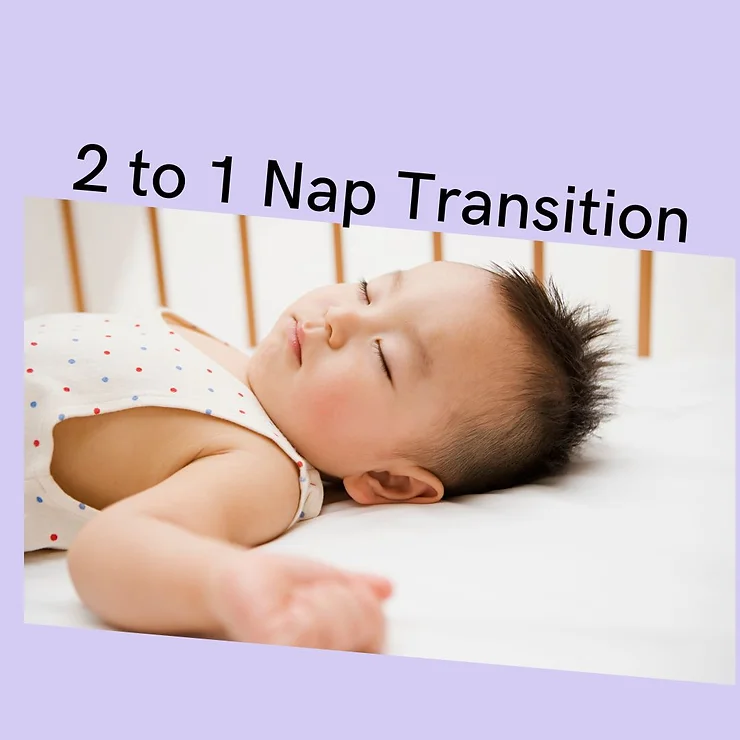The 2 to 1 nap transition is an exciting milestone! It reflects neurological growth, and brings new opportunities for adventures and activities not limited by the morning nap schedule.
Here’s some helpful information for navigating this HUGE sleep transition.
The typical time frame for readiness is between 15-18 months, and your biggest sign of readiness is that either the morning or afternoon nap is consistently declined for a 2 week period.
However, before you remove the morning nap for good, go through this checklist to confirm your suspicions.
- Are naps being offered at the right times of day?
- Are naps being offered in the right environment?
- Have you been consistent and predictable with the nap routines?
- Have you been consistent in providing a long enough opportunity for sleep during those nap times?
If that’s a “yes,yes,yes,yes”, then it’s very likely that your child is really ready for one long afternoon nap!
If you answer “no” to any of those questions, it’s worth addressing that aspect of sleep hygiene for a week or two before prematurely removing any sleep from your child’s day.
You might be wondering why so many day cares encourage or force the transition to a one nap schedule closer to 12 months. I really wish they wouldn’t! Day sleep offers important restorative value that is different from night sleep, and most babies benefit from a two nap schedule till 15 months at the very earliest. If this is your situation, I encourage communication with daycare staff to see what they can do to continue to offer a morning nap to your child. If the nap simply does not work well at daycare because it is too stimulating of an environment at this time of day, then it’s helpful to consider a temporary extra early bedtime on those daycare days when the morning nap is skipped. Then you can offer both the morning and afternoon nap on the days your child is home to minimize any issues from too little day sleep.
While every healthy sleeper is different, it’s wise to expect a gradual transition to a predictable and restorative 1 nap schedule, sometimes over the course of several months! Don’t expect to immediately see your little sleeper taking a 2-3 hour afternoon nap – but do expect to get there eventually!
It may help to offer an occasional morning nap when you can tell it’s needed. You will know it’s needed if your toddler is struggling to stay awake or keep their cool till at least 11:30am. Ideally the afternoon nap begins somewhere in the 12-1pm window. It usually needs to be offered earlier in that window initially, and then you can experiment with timing to find what works best once they are better at being awake for such a long period.
And when you do offer a morning rescue nap, this is one of those rare times that capping that morning nap and keeping it short may be indicated as well in order to preserve the more valuable afternoon sleep. So if you do need to offer an 8:30 or 9am rescue nap, you might want to cap it after only 30-60 minutes to ensure that they are still able to fall asleep for an afternoon nap beginning between 12-1pm.
Always remember your best tool for avoiding overtiredness while waiting for that afternoon nap to fully come together is a temporary extra early bedtime.
Sleep that happens in the evening before midnight is super fuel for toddler brains and will help them pay off the sleep debt that might be building during this big sleep transition.
Signs of overtiredness include increased difficulty falling asleep, increased difficulty consolidating sleep (more night wakings!) and waking up too early in the morning. If you are noticing any of these signs during a transition, shift bedtime earlier to get them into their safe sleep space well before they’re showing sleepy signs.
This transition is not always straightforward and can look different ways depending on the specifics of your child’s sleep needs and preferences. Most importantly, be patient, stay consistent with your usual sleep boundaries, use your tools. Soon enough you can enjoy longer mornings followed by long afternoon naps 🙂
If this two to one nap transition has you and your child struggling hard with sleep, consider scheduling a free 15 minute discovery call to learn more about working one on one with me to improve sleep as soon and as kindly as possible!

